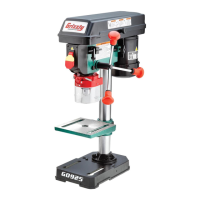Model G0925 (Mfd. Since 02/20)
-19 -
Choosing Spindle Speeds
Twist/Brad Point Drill Bits Soft Wood Hard Wood Plastic Brass Aluminum Mild Steel
1/16" – 3/16" 3000 2500 2500 2500 3000 2500
13/64" – 3/8" 2000 1500 2000 1250 2500 1250
25/64" – 5/8" 1500 750 1500 750 1500 600
11/16" – 1" 750 500 1000 400 1000 350
S
pade/Forstner Bits Soft Wood Hard Wood Plastic Brass Aluminum Mild Steel
1/4" – 1/2" 2000 1500
9/16" – 1" 1500 1250
1-1/8" – 1-7/8" 1000 750
2–3" 500 350
H
ole Saws Soft Wood Hard Wood Plastic Brass Aluminum Mild Steel
1/2" – 7/8" 500 500 600 600 600 500
1" – 1-7/8" 400 400 500 500 500 400
2" – 2-7/8" 300 300 400 400 400 300
3" – 3-7/8" 200 200 300 300 300 200
4" – 5" 100 100 200 200 200 100
R
osette Cutters Soft Wood Hard Wood Plastic Brass Aluminum Mild Steel
Carbide Insert Type 350 250
One-Piece Type 1800 500
T
enon/Plug Cutters Soft Wood Hard Wood Plastic Brass Aluminum Mild Steel
3/8" – 1/2" 1200 1000
Using Drill Bit Speed Chart
The chart shown in Figure 16 is intended as a
generic guide only. Always follow the manufac-
turer's speed recommendations if provided with
your drill bits, cutters, or hole saws. Exceeding
the recommended speeds may be dangerous to
the operator.
The speeds shown here are intended to get you
started. The optimum speed will always depend
on various factors, including tool diameter, drilling
pressure, material hardness, material quality, and
desired finish.
Often, when drilling materials other than wood,
some type of lubrication is necessary.
Lubrication Suggestions
Wood ...........................................................None
Plastics
............................................Soapy Water
Brass
...............................Water-Based Lubricant
Aluminum
..................... Paraffin-Based Lubricant
Mild Steel
............................. Oil-Based Lubricant
Figure 16. Drill bit speed chart (RPMs).
Larger bits turning at slower speeds tend
to grab workpiece aggressively. This can
result in operator's hand being pulled into
bit or workpiece being thrown with great
force. Always clamp workpiece to table to
prevent reduce risk of injury.

